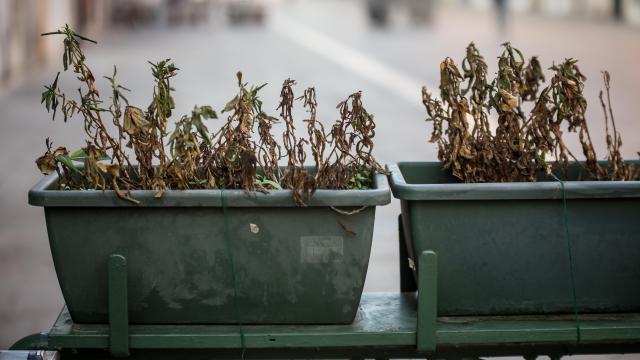In a corner of your local nursery, hidden way in the back, is a worker dumping out an endless stream of dead plants into a pile, and tossing the plastic planter into a dumpster. It looks a little like what you do at home, tossing planters at the end of the season full of dead plants, with one notable exception: The nursery soil is being recycled. You can do the same thing and save money by recycling your potting soil from year to year with a few simple steps.
Why you normally don’t reuse potting soil
All soil is soil, right? Unfortunately, there’s some nuance to that. The soil we buy in stores is made up of many components including compost, top soil, coco coir or peat, and various nutrients. Some soil is formulated to go outside into a large garden bed. That soil wouldn’t work very well in a small pot because it can’t retain moisture, and needs more nutrients for the plants. So the soil you buy for potted plants (potting soil) has additional components to retain moisture, as well as slow-release fertiliser.
At the end of the season that soil, as you’ve probably noticed, is hard as a rock, and refuses to take on water. Also, the nutrients are depleted. So nurseries always advise that you completely upend your planters and refresh that soil by breaking it up and giving it new fertilizer.
So why not just buy new potting soil? Mainly, cost. Like every other sector, gardening costs have risen dramatically in the last four years, prompted not only by the recession but also the sudden pandemic surge of gardening. Additionally, each bag of potting soil means more plastic waste (and just having to haul a bag of potting soil home). There’s some money lost in that you’re literally throwing out soil that would be perfectly usable, if you take a few steps.
How to recycle your potting soil
First, find a location where you can keep a pile of soil. It can be an area of your yard that can accommodate a literal pile, or you can use a composter or even a pop-up yard bin. At the end of the season, you’ll take off the planter and recycle it, if you can. Now break up the soil and toss it into the pile, plant and all—so long as the plant is not diseased in any way. If the plant shows sign of disease, toss that sucker in the trash, not the city composting bin. No one else wants your diseased compost either.
Wet your compost down and leave it over a season. The plant matter will decompose, which is the point of compost, infusing your soil with nutrients again. It might attract worms, which is great. Occasionally, you should mix it up with a shovel or compost stir.
At the end of the season, you can get in there, pull out some completely workable compost, and use it again either in your outdoor beds or in your potted plants by taking some out, taking a good look at it, and seeing if it needs vermiculite or another similar water-retention additive. If you’re unsure about using it for your potted plants, take some into your nursery and they can advise you. You’ll also want to add slow-release fertilizer to the mix, like Osmocote.
Some people screen their compost, meaning they literally shake the compost out over a screen, which acts like a sieve you’d use in your kitchen, letting through a uniform, finely screened compost—but that’s really not necessary.

Leave a Reply
You must be logged in to post a comment.